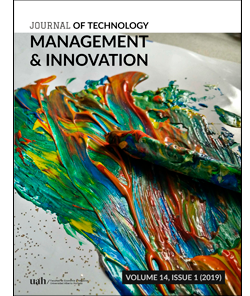A Hub-based University Innovation Model
DOI:
https://doi.org/10.4067/S0718-27242019000100011Keywords:
hub, social innovation, university innovation models, regional innovation ecosystems.Abstract
This article uses a conceptual approach to propose an innovation model for regional universities. It demonstrates that the traditional university encounters several obstacles that hinder its full integration into the development of its respective region and explains why currently known models cannot adapt to regions that have deficient relationships with the government and lack an entrepreneurial base. The new model is based on a structure composed of units called “innovation hubs” and incorporates social innovation, thus permitting the university to become integrated into the regional innovation ecosystems. The Magdalena University in Colombia was used as a reference in developing the model.
Downloads
References
Abatecola, G. (2014). Research in organizational evolution. What comes next? European Management Journal, 32(3), 434-443. https://doi.org/10.1016/j.emj.2013.07.008
Baturay, M. H. (2015). An overview of the World of MOOCs. Procedia - Social and Behavioral Sciences, 174, 427-433. https://doi.org/10.1016/j.sbspro.2015.01.685
Bell, F., Fletcher, G., Greenhill, A., Griffiths, M., & McLean, R. (2014). Making MadLab: A creative space for innovation and creating prototypes. Technological Forecasting and Social Change, 84, 43-53. https://doi.org/10.1016/j.techfore.2013.09.004
Campanelli, A. S., & Parreiras, F. S. (2015). Agile methods tailoring - A systematic literature review. Journal of Systems and Software, 110, 85-100. https://doi.org/10.1016/j.jss.2015.08.035
Carayannis, E. G., & Campbell, D. F. J. (2009). “Mode 3” and “Quadruple Helix”: Toward a 21st-century fractal innovation ecosystem. International Journal of Technology Management, 46(3-4), 201-234. https://doi.org/10.1504/IJTM.2009.023374
Carayannis, E. G., Campbell, D. F. J., & Rehman, S. S. (2016). Mode 3 knowledge production: systems and systems theory, clusters and networks. Journal of Innovation and Entrepreneurship, 5(1), 17. https://doi.org/10.1186/s13731-016-0045-9
Dedehayir, O., Ortt, J. R., & Seppänen, M. (2017). Disruptive change and the reconfiguration of innovation ecosystems. Journal of Technology Management & Innovation, 12(3), 9-21. https://doi.org/10.4067/s0718-27242017000300002
Deininger, M., Daly, S. R., Sienko, K. H., & Lee, J. C. (2017). Novice designers’ use of prototypes in engineering design. Design Studies, 51, 25-65. https://doi.org/10.1016/j.destud.2017.04.002
Florida, R. (1995). Toward the learning region. Futures, 27(5), 527-536. https://doi.org/10.1016/0016-3287(95)00021-N
Forrester, J. W. (1995). Counter-intuitive behavior of social systems. Recovered from https://ocw.mit.edu/courses/sloan-school-of-management/15-988-system-dynamics-self-study-fall-1998-spring-1999/readings/behavior.pdf
Friederici, N. (2016). Innovation Hubs in Africa: Assemblers of Technology Entrepreneurs, (October). retrieved from http://cii.oii.ox.ac.uk/wp-content/uploads/sites/38/2017/05/Friederici-thesis-Abst-TOC-Jan-2017.pdf. https://doi.org/10.2139/ssrn.3123840
Gascó, M. (2017). Living labs: Implementing open innovation in the public sector. Government Information Quarterly, 34(1), 90-98. https://doi.org/10.1016/j.giq.2016.09.003
GIZ. (2013). Technology Hubs - Creating space for change: Africa’ s technology innovation hubs. retrieved from : http://10innovations.alumniportal.com/technology-hubs.html?utm_content=buffer60fb8&utm_medium=social&utm_source=twitter.com&utm_campaign=buffer
InfoDev. (2014). The Business Models of mLabs and mHubs. Retrieved from http://www.infodev.org/infodev-files/mlab_and_mhub_publication_0.pdf
Johannsson, M., Wen, A., Kraetzig, B., Cohen, D., Liu, D., Liu, H.… Zhao, Z. (2015). Space and Open Innovation: Potential, limitations, and conditions of success. Acta Astronautica, 115, 173–184. https://doi.org/10.1016/j.actaastro.2015.05.023
Littlewood, D. C., & Kiyumbu, W. L. (2017). “Hub” organisations in Kenya: What are they? What do they do? And what is their potential? Technological Forecasting and Social Change
https://doi.org/10.1016/j.techfore.2017.09.031
Martin-Sardesai, A., Irvine, H., Tooley, S., & Guthrie, J. (2017). Organizational change in an Australian university: Responses to a research assessment exercise. The British Accounting Review, 49(4), 399-412. https://doi.org/10.1016/j.bar.2017.05.002
Molina, C., Polanco, J., & Montes, J. (2015). Foundations for governing the area of science, technology, and innovation in Medellín, Colombia. Semestre Económico, 18(38), 191-213. https://doi.org/10.22395/seec.v18n38a7
Moreno-Marín, J. C. (2002). Didactic experience in Mathematics: constructing and studying fractals. IDEAS Y RECURSOS, 91. https://www.researchgate.net/publication/39220593_Experiencia_didactica_en_Matematicas_construir_y_estudiar_fractales
Morschheuser, B., Hamari, J., Koivisto, J., & Maedche, A. (2017). Gamified crowdsourcing: Conceptualization, literature review, and future agenda. International Journal of Human-Computer Studies, 106(March 2016), 26-43. https://doi.org/10.1016/j.ijhcs.2017.04.005
Novoa, A. C. (2016). Scientific-technological innovation in Ibero-American universities. Journal of Technology Management and Innovation, 11(4), 1-4. https://doi.org/10.4067/S0718-27242016000400001
Pogačar, K., & Žižek, A. (2016). Urban hackathon - Alternative information based and participatory approach to urban development. Procedia Engineering, 161, 1971-1976. https://doi.org/10.1016/j.proeng.2016.08.788
Rao-Nicholson, R., Vorley, T., & Khan, Z. (2017). Social innovation in emerging economies: A national systems of innovation-based approach. Technological Forecasting and Social Change, 121, 228-237. https://doi.org/10.1016/j.techfore.2017.03.013
Salazar, P. H. V. (2015). Organizational factors as determiners of the impact of cooperation with businesses – A study in Latin American universities. Complutense of Madrid. (Doctoral dissertation, Universidad Complutense de Madrid). Recovered from: http://eprints.ucm.es/40850/1/T38263.pdf
Sánchez, C., Gómez-Estern, F., & de la Peña, D. M. (2012). A virtual lab with automatic assessment of nonlinear controller design exercises. IFAC Proceedings Volumes, 45(11), 172-176. https://doi.org/10.3182/20120619-3-ru-2024.00080
Sarpong, D., AbdRazak, A., Alexander, E., & Meissner, D. (2015). Organizing practices of university, industry, and government that facilitate (or impede) the transition to a hybrid triple helix model of innovation. Technological Forecasting and Social Change, 123, 142-152. https://doi.org/10.1016/j.techfore.2015.11.032
Toivonen, T., & Friederici, N. (2015). Time to define what a “hub” really is. Stanford Social Innovation Review, 1-37. retrieved from https://ssir.org/articles/entry/time_to_define_what_a_hub_really_is
Villa, L., & Melo, J. (2015). A current overview of social innovation in Colombia. Banco Interamericano de Desarrollo, 81. https://doi.org/10.18235/0000004
Youtie, J., & Shapira, P. (2008). Building an innovation hub: A case study of the transformation of university roles in regional technological and economic development. Research Policy, 37(8), 1188–1204. https://doi.org/10.1016/j.respol.2008.04.012
Wire, B., York, N., & York, N. (2016). Red Hat Launches Red Hat Open Innovation Labs, Introducing Collaborative Open Source Cloud and DevOps Residency Program, 1–4. Retrieved from: https://www.redhat.com/en/about/press-releases/red-hat-launches-red-hat-open-innovation-labs-introducing-collaborative-open-source-cloud-and-devops-residency-program
Wissema, J. G. (2009). Towards the third-generation university: Managing the university in transition. Edward Elgar Publishing. https://doi.org/10.4337/9781848446182
https://trello.com/ [Accessed: March 27, 2018]
http://www.theworldcafe.com/ [Accessed: March 27, 2018]
http://www.unimagdalena.edu.co/Institucional/Paginas/Historia.aspx [Accessed: March 27, 2018]
http://www.unimagdalena.edu.co/Institucional/Paginas/PlanGobierno2016-2020.aspx[Accessed: March 27, 2018]
http://www.unimagdalena.edu.co/Institucional/Paginas/Estructura-Organizacional.aspx[Accessed: March 27, 2018]
Downloads
Published
How to Cite
Issue
Section
License







